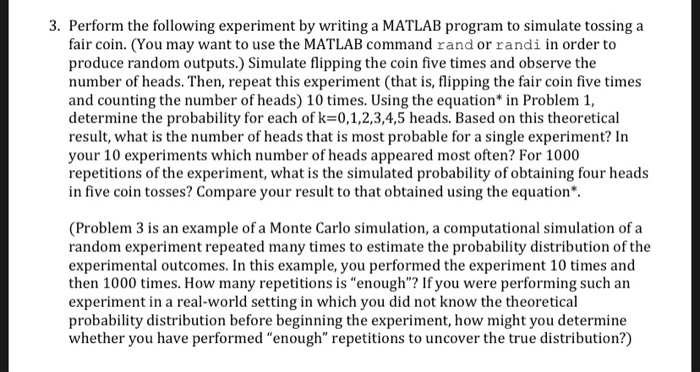3. Perform the following experiment by writing a MATLAB program to simulate tossing a fair coin. (You may want to use the MATLAB command rand or randi in order to produce random outputs. Simulate flipping the coin five times and observe the number of heads. Then, repeat this experiment (that is, flipping the fair coin five times and counting the number of heads) 10 times. Using the equation* in Problem 1, determine the probability for each of k=0,1,2,3,4,5 heads. Based on this theoretical result, what is the number of heads that is most probable for a single experiment? In your 10 experiments which number of heads appeared most often? For 1000 repetitions of the experiment, what is the simulated probability of obtaining four heads in five coin tosses? Compare your result to that obtained using the equation* (Problem 3 is an example of a Monte Carlo simulation, a computational simulation of a random experiment repeated many times to estimate the probability distribution of the experimental outcomes. In this example, you performed the experiment 10 times and then 1000 times. How many repetitions is "enough"? If you were performing such an experiment in a real-world setting in which you did not know the theoretical probability distribution before beginning the experiment, how might you determine whether you have performed "enough" repetitions to uncover the true distribution?) 3. Perform the following experiment by writing a MATLAB program to simulate tossing a fair coin. (You may want to use the MATLAB command rand or randi in order to produce random outputs. Simulate flipping the coin five times and observe the number of heads. Then, repeat this experiment (that is, flipping the fair coin five times and counting the number of heads) 10 times. Using the equation* in Problem 1, determine the probability for each of k=0,1,2,3,4,5 heads. Based on this theoretical result, what is the number of heads that is most probable for a single experiment? In your 10 experiments which number of heads appeared most often? For 1000 repetitions of the experiment, what is the simulated probability of obtaining four heads in five coin tosses? Compare your result to that obtained using the equation* (Problem 3 is an example of a Monte Carlo simulation, a computational simulation of a random experiment repeated many times to estimate the probability distribution of the experimental outcomes. In this example, you performed the experiment 10 times and then 1000 times. How many repetitions is "enough"? If you were performing such an experiment in a real-world setting in which you did not know the theoretical probability distribution before beginning the experiment, how might you determine whether you have performed "enough" repetitions to uncover the true distribution?)







